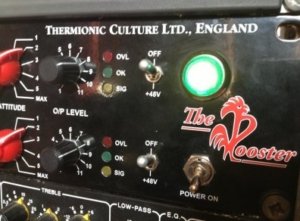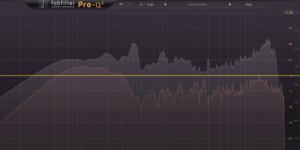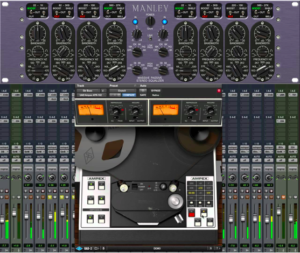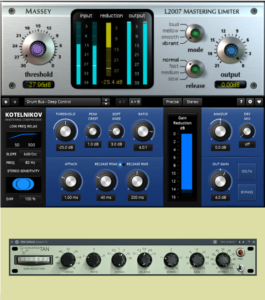STEREO BUSS PROCESSING
Hey there folks,
I am currently waiting (a long time) for mix notes from clients so I thought it would be
valuable and hopefully informative to have a dialogue about Stereo Buss Processing.
This is a massive subject that I am only going to touch on today, but as many people often
email or get in contact over social media asking about stereo buss processing its probably
due time to expand upon if only briefly. Mixing is the only thing that’s been happening here
the last fortnight, so its on my mind.
We really appreciate the conversation this platform brings with other engineers and
musicians, so please feel free to let us know what your thoughts on the
subject are and what you have been having luck with!
There are 3 main pillars of contemporary stereo buss processing.
1. Reducing the dynamic range of a mix.
2. Equalization
3. Colouration or saturation (people may use the term ‘glue’)
These usually happen in varying orders, there doesn’t seem to be a consensus of a hard and
fast rule in that regard. There are also crossovers within these separate elements, for
example some compressors that are less transparent will add colouration, or perhaps
change the mix tonally as perceivable EQ adjustment.
In short, compression and limiting is used on a mix buss to control the dynamic range. It is
to make the perceived volume of a song louder and also to provide a cohesion that marries
everything together. Equalization is used either for surgical removal of certain frequencies
and also shelving. The latter being primarily performed in the analogue domain, the former
occurring digitally sometimes even via a dynamic EQ plugin. Colouration is usually open to
interpretation, all the way from tape simulator plugins to outboard standalone transformers.
There is an interesting case of a Brisbane death metal band that once used
two separate JCM800s into PA speakers, with mics in front as the stereo buss! Recognised
as one of the most unique and remarkable heavy records of late, unbeknownst to those
working in a technical field that the process of mixdown was completely absurd.
So what should you use and when? There is no simple answer. Experiment with different processing on your mix, then listen with headphones and what other mediums you would routinely use. Take notes. Remember to always take notes and reflect on these.
Compare the mix with nothing on the buss at all and think about what characteristics you like and what you don’t. Consider if buss processing is serving the record or if it just feels interesting to you personally to have a bunch of colouration and limiting. Its completely subjective but to me I only use buss processing roughly 60% of the time. I’m not a huge fan of hearing compression working on a song, but having said that there are some genres of music (such as contemporary hip hop for example) that is based upon this mechanism. If you are unsure about buss processing its better to work without it. If you are fresh in the game it will make you a better engineer to shape a mix without heavy limiting.
Certainly with some specific genres of music, mastering engineers will do some heavy limiting on your mix. In this case it is worth performing this yourself even in a crude manner.. and then removing before printing your final mix. It is nice to have a rough idea how the final result will sound on record.
Another thing to note is heavy limiting or buss compression is something that is most definitely stuck to a time period so it is worth being aware that it may not age well.
What I used today..
The last couple records I have been running this chain so I thought I would share. Its most definitely lengthy, but I’m not doing a whole bunch at each step.
T/C Rooster > SMC2B > Pro Tools > Fab Filter Pro-Q2 > UAD Massive Passive > Ampex ATR-102 > TDR Feedback Comp > Acustica Tan > L2007
This is predominantly true with digital moreso than analogue, but multiple compressors or limiters doing less is further sympathetic to the sound rather than one heavy process from a single source. If I use stereo buss processing I usually incorporate it about one third of the way thru the session. Sometimes at the halfway mark.
When I run back into Pro Tools from the analog domain, the processing is done on an Aux track (or 2) and then printed onto another audio track and monitored back out the console.
Thermionic Culture Rooster
Fantastic dual mono pre amplifier, I use the line section first on the buss. Straight out of the console into this unit. Its coarse when you want it to be but equally transparent if you aren’t after that. Super round bottom end without introducing mud, yet also quite bright without sounding fizzy or sterile. For guitar music this unit has an incredible ability to place the mids in a really fantastic way that can give presence to guitars without having to push the volume of them to the point of smothering other instrumentation.
The way I use it is quite gentle, output pinned and trim the input till there is an amount of signal that sounds pleasing. I never use the ‘attitude’ setting. I sometimes use the vari slope shelving type curve for some 10kHz. The rotary’s aren’t stepped, so I will use an oscillator to get each side balanced.
Tube Tech SMC 2B
Multi-band tube compressor. I will at first find the best crossover points for the song. There are two points, one determines where the breakpoint is between high and mid and same with mid and low. I will then work on each band individually. The handy thing about multiband compression is when you have a bass guitar or bass drum performing a louder excursion it won’t cause the cymbals to sound odd due to them ducking out of the way comparatively. When a snare drum hits it doesn’t compress the bass guitar and so on.
This unit also has make up gain for each band, which is essentially an EQ.
From here we go back into Pro Tools.
Fab Filter Pro Q2
Surgical use. Very slight and unobtrusive cutting of certain areas, this usually happens towards the finish line. One thing I learnt from J.J. Blair was that its commonly prudent to notch out a dB of 160Hz (or thereabouts) as this is where civilian speakers get a bit strange.
(He also told me “I’m staying in the music industry to see how it ends”… so theres that.)
UAD Manley Massive Passive
Shelving EQ, gentle slope from 12kHz or 16kHz.
UAD Ampex ATR-102
I think there is a reason this has become a staple for most people. Adds goodness. Trying to avoid using every uninformative adjective in the industry that has been used in regards to this plug in. I’ve never had luck with the presets, it always takes me a huge amount of time to find the right settings but is almost always worth it.
Tokyo Dawn Feedback Comp 2
Its quite easy to get a very undesirable result with this, so caution must be excercised. Requires some very fine tweaking most of the time. I like that it is not trying to emulate some kind of sound, its just an extremely accurate digital processor. I think there is a free version that is quite similar.
Acustica Tan
Have recently been using this to trim the tops of snares or bass drums on only the very loudest excursions, utilizing the shape control setting. Very neat.
Massey L2007
Brickwall limiting, just making work of anything clipping the buss. I find myself never really touching the threshold. This is mainly acting as a safety measure.
Potential downsides
A top down approach to mixing this way often entails overlooking problems in a slew of tracks. Extensive processing on a stereo buss may create a situation where adjusting an EQ on an electric bass isn’t doing what you want because its contending with an equalizer on the stereo buss. A bunch of plug ins that are intended to add character and colour often build-up unwanted artefacts, usually in the top end. Another issue is being unable to print stems due to the relationship all tracks have with the stereo buss.
To conclude
The stereo buss is the bottleneck where everything finds its way. Every reverb tail, panning structure, moment of ambience in the room, every instrument lands here.. so be mindful of overdoing it.
Don’t feel like it is necessary to incorporate processing at this part of your chain just because it is commonplace. Some of the greatest living engineers barely touch their stereo buss.
Having said that if you are wanting to introduce these techniques, be aware that its OK to use a whole bunch of equipment or software… its just probably not the best place to start if you are new to it. If it is done tastefully and not too heavy handed it can really complete a mix.







